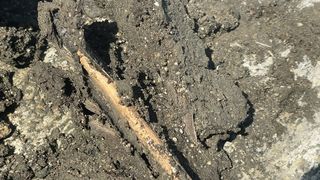'Very rare' Bronze Age arrow with quartzite tip uncovered from melting ice after 3,000 years
Glacial archaeologists in Norway have found an arrow with its quartzite tip still attached after spending up to 3,000 years in the snow and ice.

Archaeologists in Norway's mountains have discovered a "very rare" ancient arrow that still has its quartzite arrowhead and feather fletching in place.
It's likely that reindeer hunters used the weapon up to 3,000 years ago, according to archaeologist Lars Pilø, who heads the Secrets of the Ice project in the Jotunheimen Mountains of central Norway's Oppland region.
While archaeologists with the project have previously found human-made hunting blinds where hunters hid while targeting reindeer, the newfound arrow wasn't unearthed near one.
"There are no hunting blinds in the immediate vicinity, but this arrow was found along the upper edge of the ice, so the hunters may simply have been hiding behind the upper ridge," Pilø told Live Science in an email.
Related: 25 things found frozen in Europe's mountain ice
Secrets of the Ice glacial archaeologist Espen Finstad discovered the arrow on Sept. 13. Due to human-caused climate change, the snow and ice in the Jotunheimen Mountains is melting, exposing artifacts from hundreds to thousands of years ago. If archaeologists don't find these human-made items quickly after being exposed, the artifacts can deteriorate in the elements.
Finstad found the arrow during a targeted survey, when he and colleagues "checked newly exposed areas along the edge of the ice," Pilø said.
Sign up for the Live Science daily newsletter now
Get the world’s most fascinating discoveries delivered straight to your inbox.
An analysis revealed that the arrow's shaft was made of birch and that it still had an aerodynamic fletching with three preserved feathers. Hunters use fletching to help guide the arrow in flight, but these typically decay over time.

The quartzite arrowhead at the front of the shaft "is barely visible because pitch covers most of the arrowhead," Pilø said. "The pitch was used for securing the arrowhead to the shaft and to smooth the front of the arrow, allowing for better penetration. Arrows with preserved arrowheads still attached are not uncommon during the Iron Age on our ice sites, but this early they are very rare."
The pitch likely came from birch charcoal, he added.
Despite its well-preserved arrowhead and feathers, the rest of the arrow fared slightly worse. The roughly 2.9-foot-long (90 centimeters) arrow broke into three pieces along its shaft, "probably due to snow pressure," Pilø said.
Editor's note: Updated at 9:45 am EDT to correct the arrow's age. It is not from the Iron Age, but from the Bronze Age up to 3,000 years ago.

Laura is the archaeology and Life's Little Mysteries editor at Live Science. She also reports on general science, including paleontology. Her work has appeared in The New York Times, Scholastic, Popular Science and Spectrum, a site on autism research. She has won multiple awards from the Society of Professional Journalists and the Washington Newspaper Publishers Association for her reporting at a weekly newspaper near Seattle. Laura holds a bachelor's degree in English literature and psychology from Washington University in St. Louis and a master's degree in science writing from NYU.
Most Popular


